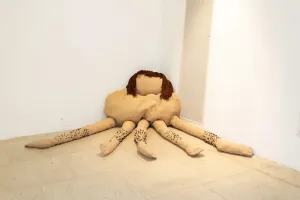Oľga Paštéková: Paintings where nature speaks back
Slovak painter Oľga Paštéková turns stains, bleaches, and ghosted lines into wolves, rivers, and lantern-houses, lyrical eco-paintings from Bratislava & Vienna.

Explore the vibrant evolution of textile art, where traditional techniques meet cutting-edge innovation. Artists weave, stitch, and dye their way into groundbreaking forms, transforming fabrics into stunning narratives and tactile experiences. This resurgence highlights textile art's versatility and cultural significance, propelling it into contemporary galleries and digital platforms. Dive into the latest trends in textile art
Slovak painter Oľga Paštéková turns stains, bleaches, and ghosted lines into wolves, rivers, and lantern-houses, lyrical eco-paintings from Bratislava & Vienna.
Ophelia Arc’s visceral textile sculptures stitch trauma, memory, and feminist psychoanalysis into haunting forms.
Rosina Rosinski’s textile works abandon canvas for quilted absence—velvet, polyester, and emotion stitched into haunting, intimate spaces.
Meet Filzmäuse, a wickedly creative artist collective weaving wit, wool, and wild ideas into something delightfully absurd. Formed in Vienna in 2024, this quartet challenges what a textile-based practice can be, with felting needles, humor, and sharp instincts.
Step into the immersive world of Hugo Brazão, where sculpture, textile, and painting blur into vibrant spaces of memory, fiction, and escapism. In this in-depth interview, the artist reflects on childhood clay, cruel optimism, and the power of color as both camouflage and rebellion.
Discover the mesmerizing world of Meike Legler, where textiles transcend tradition to explore the cosmic mysteries of existence. Explore now!